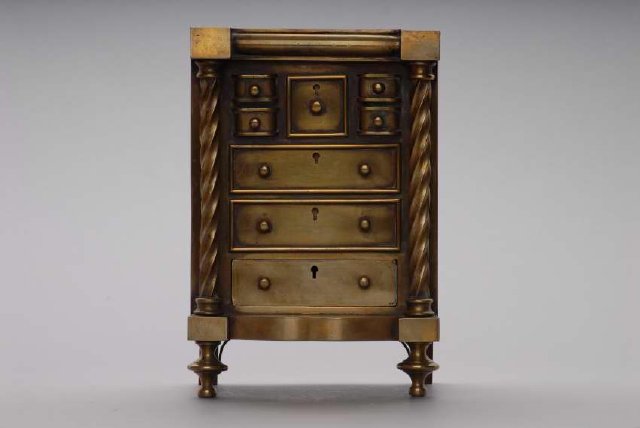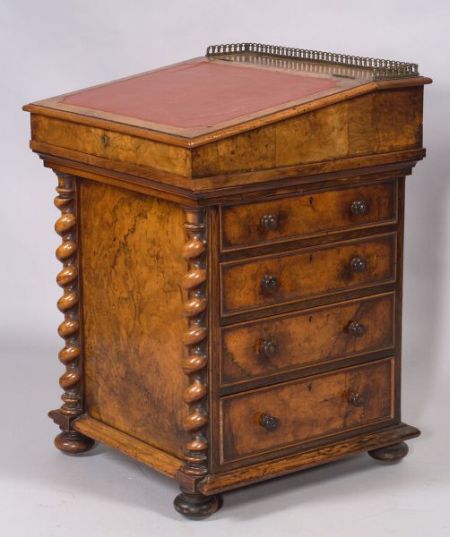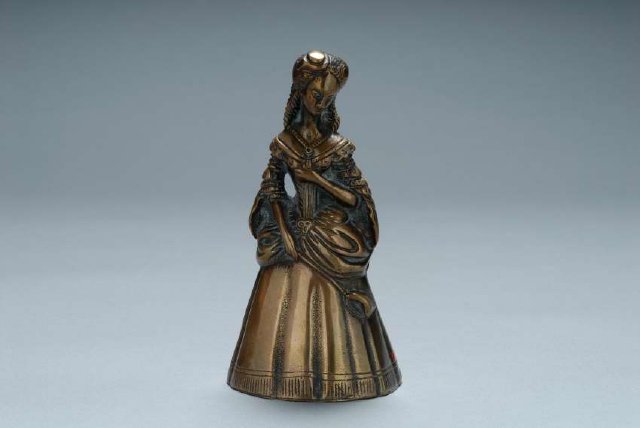Long before Jonathan Swift published Gulliver’s Travels in 1726, miniature items have held a special fascination. Even after childhood has passed, the delight in playing a “giant” and the curiosity or surprise of what’s inside tiny containers can still gratify. It was likely the emotional appeal that spurred Arthur Nichols to purchase this tobacco box on impulse, when he saw it at a Boston auction house. In February of 1912, Arthur Nichols wrote in his diary that he had attended a sale of “bric-a-brac from England” at Libbie’s Auction House on Boylston Street in Boston and that he had “bought a brass tobacco box in shape of a miniature highboy….”

While “Highboy” is the colloquial term for an antique chest of drawers, the furniture form upon which this little brass box is based is a combination of a chest of drawers and an English “Davenport,” or a type of small desk. The type was invented ca. 1816 for a Captain Davenport to use at sea where space was at a premium, and later migrated to the domestic sphere through the rest of the century [1]. The illustration below shows a full-size Davenport executed in wood.

Our example has the arrangement of small drawers and twisted columns often seen on full-sized Davenports, but the drawers are arranged in the front, like a dresser or chest of drawers. But it does share all the “bells and whistles” with the real things: a beautifully proportioned case, a set of expertly crafted locked drawers in graduated sizes, dynamic “barley twist” supports at the front and delicate turned feet.
We know Dr. Nichols loved polished brass. Practical and affordable, it is no wonder. While the family had an extensive silver collection for dining, brass articles were used throughout the household: candlesticks, trivets, inkstands, andirons and fireplace tools. With its soft sheen, “brass was the perfect emblem of respectable wealth” [2].
As attractive as it is on its own terms, this little box is also useful. It is among the numberless smoker’s accessories in brass turned out by the English eighteenth and nineteenth-century metalworking industry, which was centered around the city of Birmingham [3]. The box has a flat lid, which opens to reveal a large steel-lined compartment for the storage of loose tobacco or cigars. All the drawers are “dummies” except for the one on the bottom, meant for storing matches. Each part would have been cast of brass (an alloy of copper and zinc), filed, polished and assembled. Metalworkers crafting miniature items often had to use tiny tools scaled to suit the job [4]. Other objects for the gentleman’s study included snuff boxes, pipe stoppers, cigar cutters, as well as letter boxes, paper weights and seals, many in novel and amusing shapes such as animals, fictional characters, or furniture.
Another example of a miniature brass novelty item in the Museum’s collection is this small bell in the form of a woman, sized perfectly for the table or shelf. Interestingly, both the tobacco box and this bell were designed in an early nineteenth-century style, whether or not they actually date from that period. The hairstyle and apparel shown here, including a lace shawl collar and a wrap, model an example of demure femininity that was quite old-fashioned at the time of its purchase by the Nichols family. Our little lady, grasping a butterfly net for a summer afternoon gentle past-time, was a nostalgic artifact.

Dr. Nichols was known to smoke the occasional cigar, but there may have been more behind this purchase than mere practicality. Perhaps it was the irresistible appeal of the miniature and of “tuygs.” Items like this box were collected as “toys,” from the Dutch word tuygs, meaning “trifles that amuse adults” [5]. He also used the box to amuse his grandchildren, who have recalled that after dinner Dr. Nichols would take it down from the fireplace mantle and dole out “red hot” candies from it [6]. The candies were sure to please, especially dispensed from an object that looked like a desk or dresser that was meant to hold tobacco – just the sort of visual joke that would delight the child in everyone.
By Rosemary Battles Foy, Nichols House Museum Volunteer Researcher and Independent Design Historian
[1] Fleming, John and Hugh Honour, The Penguin Dictionary of Decorative Arts (London: Viking/Penguin, 1989), 237.
[2] Gentle, Rupert and Rachel Field, English Domestic Brass: 1680-1810 and the History of its Origins (New York: E. P. Dutton, Inc., 1975), p. 69.
[3] Ibid, p. 45.
[4] Lindsay, J. Seymour, Iron and Brass Implements in the English and American Home (Medici Society, 1927) p. 170.
[5] Latham, Jean, Collecting Miniature Antiques (New York: Charles Scribner’s Sons, 1972), p. 101.
[6] Nichols House Museum object file, as reported to Museum Historian William Pear.


You must be logged in to post a comment.